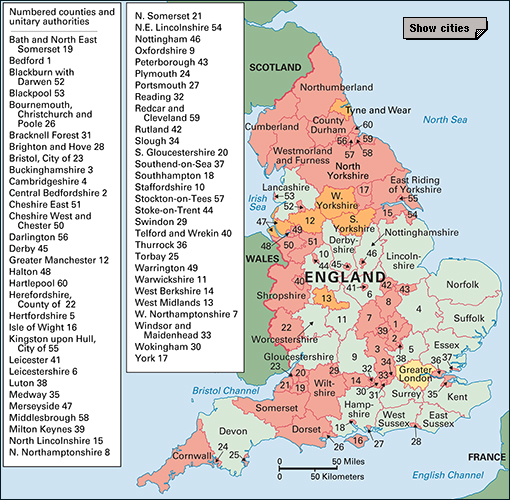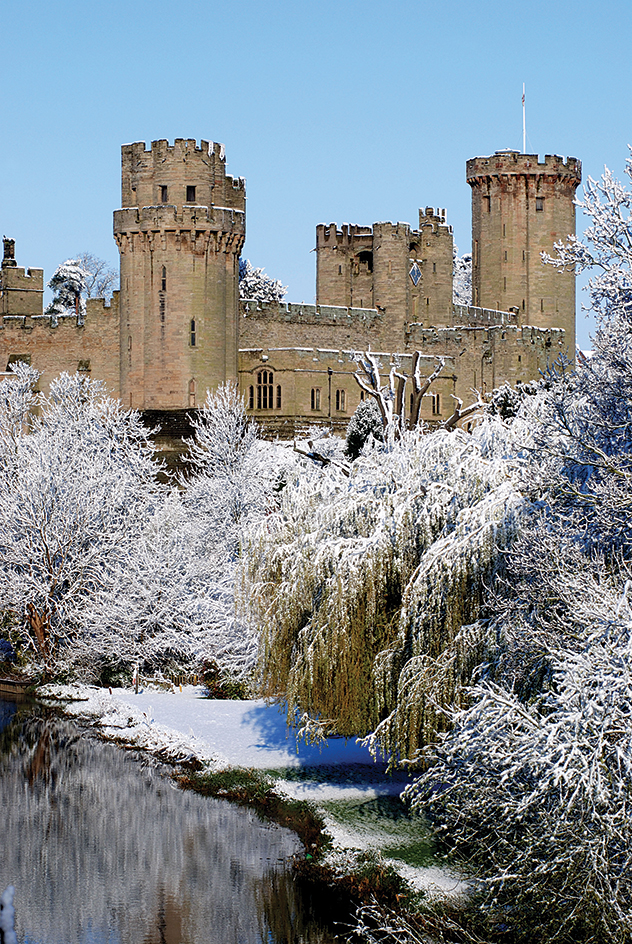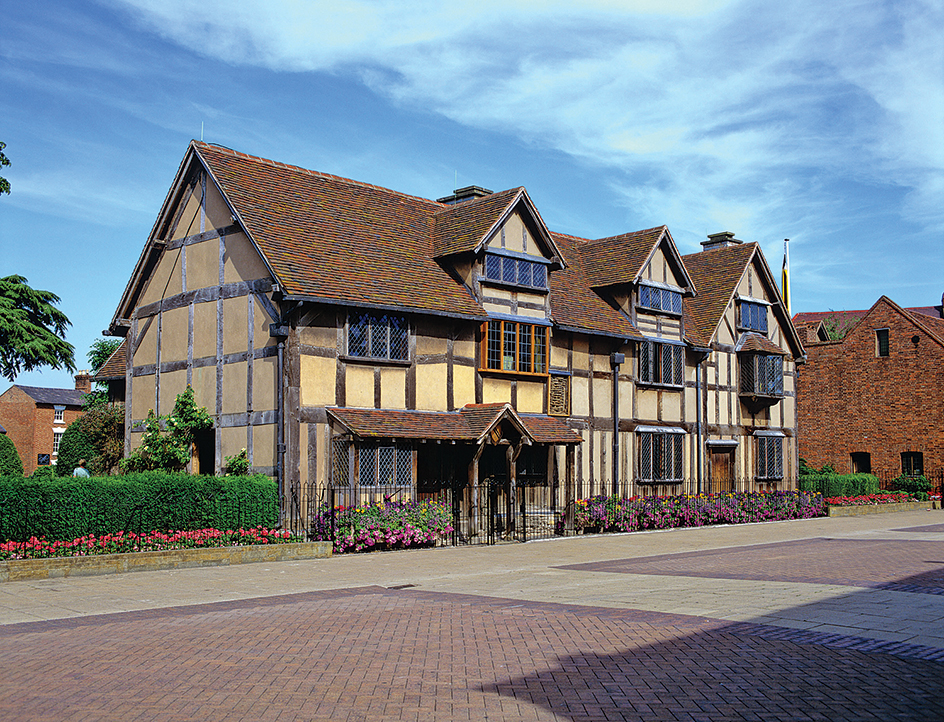Warwickshire (pop. 596,773), famous for its associations with William Shakespeare, lies in the heart of England. The beautiful countryside has meandering rivers, fertile farmland, and leafy lanes. The county covers an area of 763 square miles (1,975 square kilometers). Its administrative center is Warwick.

In 1974, Warwickshire was reduced in size. A large area in the northwest was taken into a new neighboring county called West Midlands. This area included the cities of Birmingham and Coventry. The county contains the famous independent school of Rugby, founded in 1567. One of its headmasters, Thomas Arnold, became famous for his reforms at the school.
People and government
Local customs.
Welford-on-Avon has a maypole on the village green and holds traditional May Day celebrations each year. On St. Martin’s Day (November 11), people place small sums of money, called wroth silver, in a hollow stone. The money is collected by the agent of the Duke of Buccleuch, the lord of the manor.
Recreation.
Rugby football originated at Rugby School in Warwickshire, and is still popular in the county. The county cricket team plays in first-class cricket. A traditional game of football is played every Shrove Tuesday in the streets, rivers, and canals of Atherstone, a village in northeastern Warwickshire. The ball is decorated with ribbons, and is filled with water. Many people go boating or fishing on the River Avon. Horse racing is popular at the racecourses of Stratford-upon-Avon and Warwick.
Local government.
Warwickshire is divided into five local government districts. They are North Warwickshire, which includes Atherstone; Nuneaton and Bedworth; Rugby; Stratford-on-Avon; and Warwick. The crown court meets at Warwick. The county’s police force is the Warwickshire Constabulary, which has headquarters near Warwick.
Economy
Agriculture
is important in Warwickshire. Much of the farmland is pasture, supporting herds of dairy cattle. In the Avon Valley, growers produce apples, pears, and plums. This area has some market gardeners. Farmers grow wheat, oats, and root crops in all parts of the county. Warwickshire has some of England’s most intensively cultivated land. The National Agricultural Center is at Stoneleigh and is the venue for the annual Royal Show, the United Kingdom’s biggest agricultural show.
Manufacturing.
Manufacturing accounts for nearly one-third of employment in the county. Metal goods industries employ most workers. In the rural areas, some traditional industries survive. Examples are hurdle making, boat building, and thatching.
The county’s main industrial centers are Rugby and Warwick. Some of the world’s largest power stations use generators and transformers made in Rugby. Rugby also produces cement and lasers, and is a center for distribution companies. Warwick has a growing service industry for computers and electronics, as well as engineering factories producing hinges, garbage collection vehicles, and pumps. Other products made in Warwickshire include automobile parts, gas heaters and stoves, and clothing and textiles.
Leamington’s factories produce gas fireplaces and cookers, as well as components for automobiles and aircraft. Warwick has a growing service industry for computers and electronics, as well as engineering factories producing hinges, refuse collection vehicles, and pumps. Stratford-upon-Avon industries include boat building, engineering, and fruit canning. Alcester produces mowing machines and laboratory equipment. Needle making has been an industry at Studley since the 1100’s. Today, workers produce needles for many uses.

Tourism.
Stratford-upon-Avon, which is Shakespeare’s birthplace, and Warwick, with its castle dating to the 1300’s, are two of the United Kingdom’s major tourist attractions. Leamington is a tourism and conference center.

Transportation and communication.
Inter-city train services provide links to London, Birmingham, and Rugby. The county has good road connections. The M1, M40, M45, and M6 connect London and the South East with the North West, and the M5, M42, and M69 connect the South West with the North East and Scotland. Leamington and Nuneaton publish daily newspapers. Several towns have local weekly newspapers. Two independent local radio stations, Mercia Sound and Coventry and Warwickshire Radio, are based at Coventry.
Land and climate
Location and size.
Warwickshire is bordered by Leicestershire and Staffordshire on the north, Northamptonshire on the east, Gloucestershire and Oxfordshire on the south, and West Midlands and Worcestershire on the west. Its greatest distances are 47 miles (76 kilometers) from north to south and 35 miles (56 kilometers) from east to west. It lies at the south of the Midland Triangle, an important industrial area formed in the north by the Trent Valley and the chain of hills known as the Pennines, and on the two other sides by the valleys of the Severn and Avon.
Land features.
Warwickshire has three main, well-defined geographical regions.
In the northwest part of the county, gently rolling hills rise to 600 feet (180 meters) above sea level. A tongue of low-lying country, extending from Tamworth to Kenilworth, cuts into the upland area.
The flat, lowland area of the Avon Valley, less than 300 feet (90 meters) above sea level, crosses Warwickshire from the northeast to the southwest.
The steep northwestern slopes of the Cotswold Hills form a second upland area, lying along the southeastern boundary of the county. Brailes Hill, the highest in the county, lies in these uplands. It rises to 757 feet (231 meters). Farther east, the uplands become the Northamptonshire Heights.
Rivers.
The Leam, Sowe, and Stour rivers flow into the Warwickshire Avon in the central and southern parts of the county. The Avon rises in Leicestershire and enters Warwickshire near Rugby.
Climate.
Warwickshire has some of the most pleasant weather in the Midlands. Sheltered by the Welsh mountains to the west, the county has an average annual rainfall of between 25 and 30 inches (635 and 760 millimeters), lower than the average for England. The warm westerly winds traveling up the Avon Valley help to keep the average January temperature above 41 °F (5 °C) and the average July temperature above 63 °F (17 °C).
History
In prehistoric times, most of the area that is now Warwickshire was covered by the vast Forest of Arden. This forest extended from the Avon to the northeastern border of the present county. The area was difficult for prehistoric people to settle in.
The first English settlers inhabited the Severn and Avon valleys during the A.D. 500’s. In the 600’s, this area became part of the kingdom of Mercia. In the 900’s, Ethelfleda, also spelled Aethelflaeda, the oldest daughter of King Alfred, fortified Warwick. In the 1000’s, William the Conqueror built a castle on the same site.
Kenilworth Castle, built in the 1100’s, was a royal residence until Henry III gave it to Simon de Montfort. Simon made the castle his headquarters during the baronial plot against the monarchy.
During the Wars of the Roses, the Earl of Warwick, also called the Kingmaker, supported the Yorkist claim to the throne, and helped to defeat and capture the Lancastrian king, Henry VI. After a quarrel with Edward IV, Warwick transferred his allegiance to the Lancastrians and helped to restore Henry to the throne. Later, when Warwick was killed at the battle of Barnet, in Hertfordshire, Edward IV regained the throne.
The first battle of the English Civil War was fought in Edgehill, in the southern part of the county, in 1642. The battle was indecisive. All the early conflicts of this war took place in Warwickshire. The castles of Warwick, Tamworth, and Kenilworth were besieged many times by the opposing sides.
Shakespeare was born at Stratford-upon-Avon, the poet Rupert Brooke was born at Rugby, the novelist George Eliot was born at Nuneaton, and the novelist Elizabeth Gaskell went to school at Barford.
